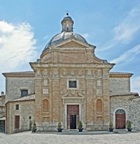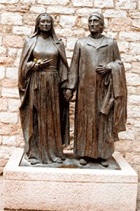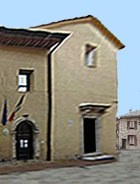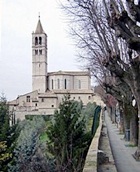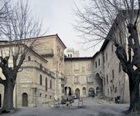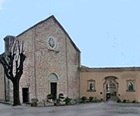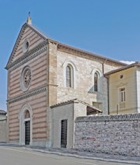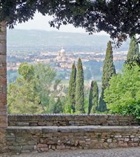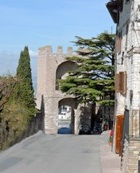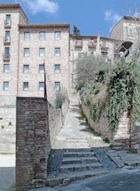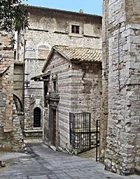This walk starts in Piazza del Comune.
Leave the piazza through Via Arco del Priori, to the right of the oldest part of
Palazzo dei Priori . Piazza della Chiesa Nuova is on the left, behind the palace. It was known as Platea Macelli in the Middle Ages because the abattoir of Assisi was located here, behind The Commune acquired this abattoir in 1508, when the palace was largely rebuilt. The reinforced foundations at the rear of the palace date to this period
The piazza is now named for the
Chiesa Nuova, which was built on the presumed site of the house in which St Francis grew up.
A Roman well has been excavated under the piazza.
The bronze statue (1984) by
Roberto Joppolo to the right of the church depicts Pietro di Bernardone and Madonna Pica, the parents of St Francis. Madonna Pica holds the chains from which she had released St Francis while Pietro holds the clothes that St Francis discarded when he subsequently renounced his inheritance. Both faces display a great sense of loss.
Continue to the end of Vicolo Superiore di Sant' Antonio (to the left of the church) to visit
San Francesco Piccolino.
Return to Via Arco del Priori. There is an entrance to the Museo Civico and the Archaeological Area across the street, under the arch and on the right. (The main entrance is in Via Portica - see Walk I). Even if you are not visiting the museum, it is worth looking inside: the south eastern corner of the Roman forum can be seen diagonally across the room.
Return to Via Arco del Priori and continue along it to the junction with Via Sant' Antonio. The ex-convent of
Sant' Antonio da Padova (now a school) is to the right.
Continue along Vicolo Arco di Sant' Antonio, which runs along the right wall of the ex-church.
A fresco (early 16th century) of the Madonna and Child with St Francis and another (damaged) saint (presumably St Antony of Padua), which is attributed to
Tiberio d' Assisi, was detached from the arch across this street is now in the
Pinacoteca Comunale.
Walk down the steps on the left of the oratory and take a short detour by turning right along Via Porta Moiano:
-
✴the gate on the right opens into the garden of the Palazzo Vescovile (see below, to the right in this photograph), which stands on foundations provided by the Roman walls.
-
✴the new walls that were built in ca. 1260 to bring Santa Chiara (see below) within the city walls are on your left.
Continue to
Porta Moiano. (The gate of the garden of Palazzo Vescovile that was mentioned above can be seen in the wall on the right in this photograph).
Take a short detour by continuing for a little way. The ex-church of San Pietro Campagna is on your right, at number 197a. [I cannot discover anything about this tiny church. ]
Return along Via Porta Moiano to the steps that led down from the oratory. and turn right down another flight to the
Fonti di Moiano (signed for the escalator that leads down to the car park).
Continue along Via delle Fonti di Moiano, with a lovely view of Santa Maria Maggiore (see below) to the left and the Torre del Popolo, San Rufino and Rocca Maggiore.
The road then runs along the side of Santa Chiara (see below), between:
-
✴the inner city walls that were built around the nunnery in ca. 1260 (on your left); and
-
✴the outer city walls, which were built after 1316.
It then runs along the back of the complex that belonged to the Confraternita di Santa Chiara.
Take a short detour by turning left along Via Borgo Aretino to see the front of the Confraternita di Santa Chiara, which now belongs to the Suore Svedesi di Santa Brigida. Retrace your steps and walk through the gate.
Turn right outside Porta Nuova along Via Santureggio. Turn right along the busy Viale Vittorio Emanuele II and then 1st left along Via Padre Antonio Giorgi. The remains of a Roman nymphaeum ("Sanctus et Regius Fons", consecrated and royal fountain) are in the garden of the to Ristorante Paradiso, on the right.
Continue to to
San Damiano, the church and nunnery in which St Clare spent most of her life and the place in which she died.
Turn right on leaving the church. The bronze statue (1912) of St Clare by
Cesare Aureli on your left was erected on the 7th centenary of the year in which St Clare began her religious life.
Continue through the olive groves along Via Giorgio F.S. Robinson, Marchese di Ripon: it is named in memory of George Robinson, Lord Ripon, who bought the complex of San Damiano from the Italian state in 1894, paid for its restoration and gave the use of it back to the Franciscans.
... and the remains of a Roman mausoleum (1st century AD) to the right of it. A number of Roman funerary monuments have also been found here, including a number belonging to the Propertius family that are now in
Museo Civico.
Walk under the main road and climb the steps on the right. Turn right at the end, along a retaing wall, with an API petrol station above on the left. Turn right along Via Madonna dell’ Olivo until the point where Via San Benedetto forks off it to the left. The abandoned tiny church of Santa Maria dell’ Olivo is almost hidden among the olive trees in the field opposite the junctin on the right.
Retrace your steps and continue past the API petrol station (now on your left) to Porta Nuova. Continue along Via Borgo Aretino, following the path taken by the procession that carried St Clare's body to San Giorgio in 1253. The present church of
Santa Chiara was built on this site shortly afterwards. There are lovely views of the apse of the church and its campanile from the road.
As you approach the apse, the road passes under the
Arco di Santa Chiara, which was part of the extension of the city wall in ca. 1260 to protect the nunnery. This was the site of the so-called Trivio di San Giorgio, which was named for the parish church of San Giorgio and an adjoining school and hospice, all of which belonged to the canons of San Rufino. This was probably where "the people" attacked the men who were bringing the sarcophagus of
St Rufinus into Assisi in ca. 1050 at the behest of Bishop Ugone. The Bishop's men were trying to take it to Santa Maria Maggiore (to the left - see below), but "the people" diverted it to the shrine of San Rufino (to the right, the site of the present church of San Rufino).
The road continues as Via Santa Chiara, along the side of the church to the Portella di San Giorgio (13th century). It replaced a a gate in the
Roman wall, traces of which survive below the current street level.
Continue into Piazza Santa Chiara, to the entrance to the church. The piazza was extended onto an artificial terrace in the 1872. The polygonal
fountain, which was designed by Attilio Cangi, was installed at this time.
Leave Piazza Santa Chiara by Via Sant' Agnese ahead. There is a fine stretch of
Roman wall near number 12 on the right.
and part of a Roman wall and a well inside the restaurant.
Follow Via Sant’ Agnese into Piazza del Vescovado. This was the site of a Roman necropolis, and a number of cinerary urns that were found here are now in the
Museo Civico (exhibits 163 and 169). The road splits the piazza into two, with Palazzo del Cardinale and Palazzetto Vannola on the right as you enter the piazza (to the right and left respectively in this photograph). They are both described in the page on
Patrician Palaces).
The main part of the piazza is on the other side of Via Sant' Agnese, with the
Fontanella del Lione (visible in the picture above) at its centre. If you stand in front of the fountain with Via Sant’ Agnese behind you:
-
✴Santa Maria Maggiore is on the left, and the so-called House of Propertius is reached from its crypt; an
-
✴Palazzo Vescovile is in front of you.
Leave Piazza del Vescovado by Via Giovanni di Bonino (opposite Santa Maria Maggiore). The entrance to the nunnery of
San Quirico is at number 5 on the right.
-
✴San Paolo delle Abbadesse (with its façade parallel to the street); and
-
✴Sant' Apollinare (with its façade at right angles to it).
Continue along Via Sant' Apollinare. A long stretch of the
Roman walls can be seen high up in the gardens on the right as it swings away from the 14th century circuit towards Piazza Garibaldi (see below).
Beyond the turning on the left, which leads to
Porta del Sementone, the road becomes Via Borgo San Pietro, which is named for the large suburb that was enclosed by the new walls in the early 14th century. The
Monastero di Santa Colette is at number 3, ...
with the Galleria d' Arte Contemporanea della Pro Civitate Christiana opposite.
There is a lovely view of Santa Maria degli Angeli in the plain below the city (see Around Assisi) from the viewing point on the right in the photograph above.
On leaving the church, continue along Via Borgo San Pietro, past the neo-Romanesque Casa Capello (1921) on the left.
Porta di San Pietro, a gate in the 14th century walls, is ahead. Stay inside the walls and turn sharp right along Via Monsignor Niccolini, which is named for Bishop
Giuseppe Placido Niccolini.
Take the stepped Vicola Illuminata (the first left).
Follow this narrow street to the right, passing
Ristorante Il Frantoio, which is named for the abandoned millstone at number 10 on the right, and then turn left up the steps of Vicolo di Via Fontebella.
The street is named for the
Fonte Marcella, which is further along on the right, at the foot of the rear wall of the
Monte Frumentario. The terrace opposite offers a panoramic view.
The road continues to Piazza Garibaldi, close to the point at which the road from Perugia entered the city through Porta Urbica, the only gate in the
Roman walls that survives
in situ. The remains of this gate in
Palazzo Fiumi-Roncalli on the right are not accessible to the public, but they are illustrated in this page of the website
Assisi Itinerari © 2017.
Return to Piazzetta Garibaldi and turn sharply right along Via E. Brizi, which follows the line of the Roman road that led to the forum. This becomes Via Giotto. The neo-Gothic Casa Leonelli (1926) at number 1 on the right has an ancient statue of a lion on the low wall to the left of the entrance. The inscription on the adjacent house to the left (at number 17 Piazza Sbaraglini) records that Giuseppe Leonelli was killed on the Austrian front in 1915.
Turn right across Piazza Sbaraglini, which is named for Giueseppe Sbaraglini (1870-1947), a lawyer from Perugia who was persecuted by the Fascist government of the 1930s. He became mayor of Assisi after the Second World War.
Continue into Via Bernardo da Quintavalle. The house of Brother
Bernard of Quintavalle, an early follower of St Francis, is at number 10 on the right. This house was bought by Giueseppe Sbaraglini in ca. 1945 and is sometimes still referred to as Casa Sbaraglini.
Continue past Palazzo Giampè (17th century), at number 3a on the right. This palace stands on the site of a
Roman domus.
Take the next left into Via Arco del Priori and continue into Piazza del Comune, where the walk ends.



